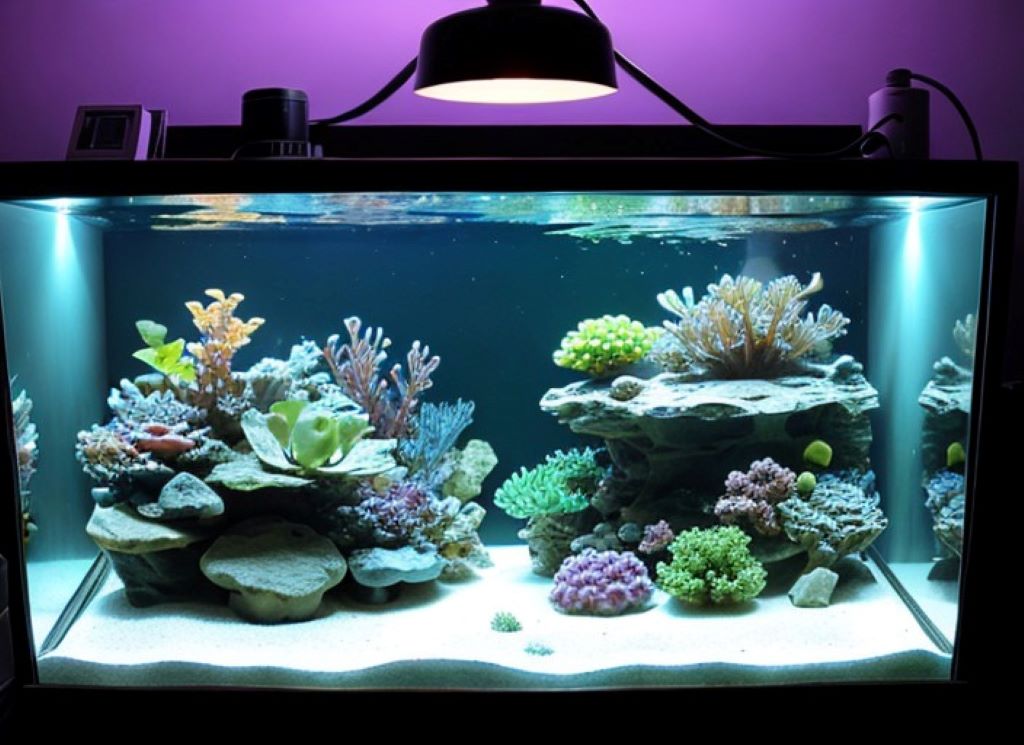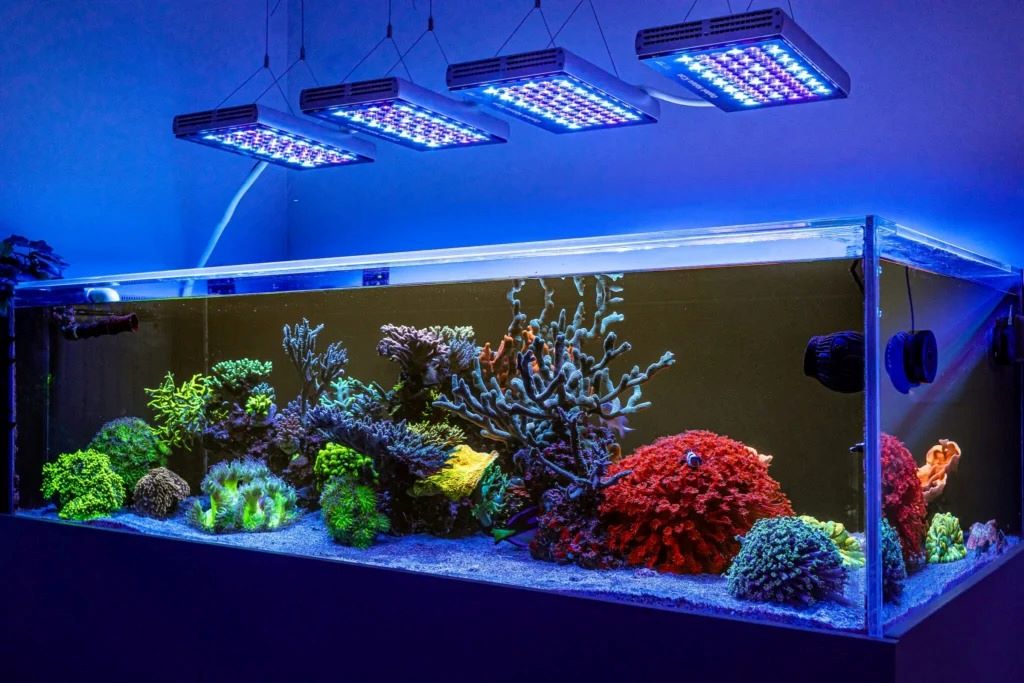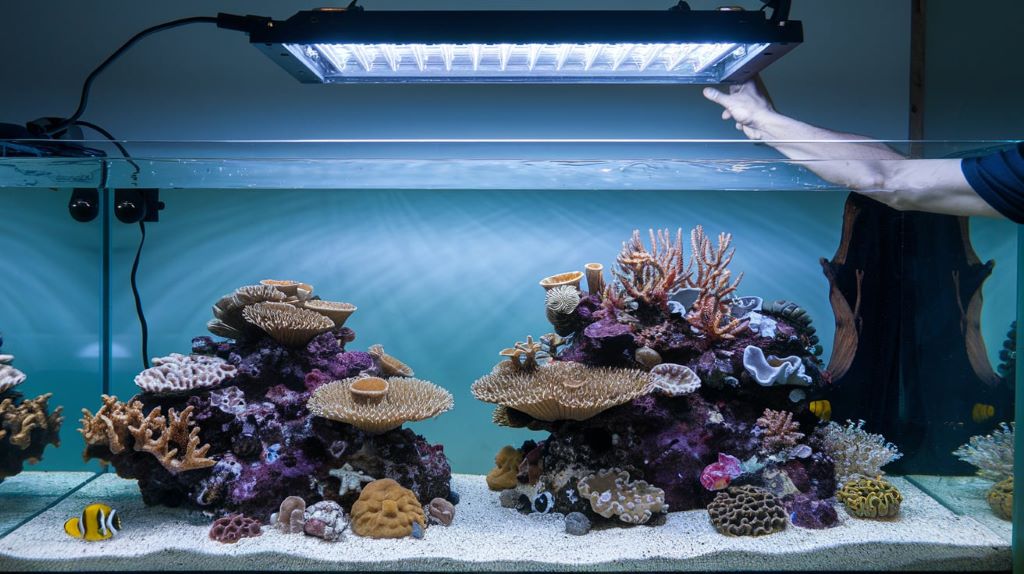The shimmering dance of light through an aquarium, highlighting the vibrant colors of fish and the lush tapestry of aquatic plants, is a captivating sight. But the importance of aquarium lighting goes beyond aesthetics; it’s a fundamental element that influences the health and vitality of your underwater ecosystem.
Whether you’re a seasoned aquarist or just starting your aquatic journey, understanding the lighting requirements for your aquarium is crucial. This comprehensive guide delves into the intricacies of aquarium lighting, providing you with the knowledge and tools to create a thriving and visually stunning aquatic environment.
Why is Aquarium Lighting So Important?
Light is the lifeblood of any aquarium, playing a pivotal role in two key processes:
- Photosynthesis: For planted tanks, light is the driving force behind photosynthesis, the process by which plants convert light energy into chemical energy to fuel their 1 growth. Adequate lighting ensures healthy plant growth, which in turn provides oxygen, consumes nitrates, and creates a natural habitat for your fish.
- Fish Health and Behavior: Light regulates the circadian rhythm of fish, influencing their sleep-wake cycles, feeding habits, and overall well-being. Proper lighting helps maintain their natural behaviors and reduces stress, contributing to a healthy and vibrant aquatic community.
Factors Influencing Aquarium Lighting Needs
Determining the ideal lighting for your aquarium involves considering several factors:
- Aquarium Size and Depth: Larger and deeper tanks require more powerful lighting to ensure sufficient light penetration to the bottom, especially for plant growth.
- Types of Plants: Different aquatic plants have varying light requirements. Some thrive in low light, while others demand high-intensity illumination for optimal growth. Research the specific needs of your chosen plants.
- Fish Species: While most fish adapt to a range of lighting conditions, some species, particularly those from deep-water habitats, may prefer dimmer environments.
- Aquascaping: The arrangement of rocks, driftwood, and plants can create shadows and affect light distribution. Consider your aquascape design when planning your lighting setup.
Types of Aquarium Lighting
A variety of lighting options are available, each with its own advantages and considerations:
- Fluorescent Lighting: A popular and affordable choice, fluorescent tubes provide good light output and come in various spectrums to cater to different needs. T5 and T8 are common types, with T5 being more energy-efficient and offering higher intensity.
- LED Lighting: LED lights have gained immense popularity due to their energy efficiency, longevity, and versatility. They offer customizable color spectrums and can be programmed to simulate natural daylight cycles, enhancing the visual appeal and promoting natural behaviors in fish and plants.
- Metal Halide Lighting: These high-intensity lights are ideal for deep tanks and demanding plants but generate significant heat and consume more energy. They are often used in reef aquariums to support coral growth.
Understanding Lighting Spectrum and Intensity
- Spectrum: Light is composed of different wavelengths, each corresponding to a specific color. Plants primarily utilize red and blue wavelengths for photosynthesis. Full-spectrum lights, mimicking natural sunlight, provide a balanced spectrum beneficial for both plants and fish.
- Intensity: Light intensity is measured in PAR (Photosynthetically Active Radiation), which quantifies the amount of light available for photosynthesis. Low-light plants require 10-20 PAR, while high-light plants need 40-80 PAR or more.
Calculating Lighting Requirements

While general guidelines exist, calculating the precise lighting needs for your aquarium involves considering the interplay of various factors. Here’s a simplified approach:
- Determine Tank Volume: Calculate the volume of your aquarium in gallons or liters.
- Choose Lighting Technology: Select the type of lighting that suits your needs and budget (fluorescent, LED, or metal halide).
- Estimate Watts per Gallon: A common rule of thumb is to use 1.5-2 watts per gallon for low-light tanks, 2-3 watts for medium-light tanks, and 3-4 watts or more for high-light tanks. However, this is a rough estimate and can vary depending on the efficiency of your chosen lighting and the specific needs of your plants.
- Consider Light Penetration: Water depth significantly affects light intensity. For deeper tanks, choose high-output lights or consider adding supplemental lighting to ensure adequate light reaches the bottom.
- Adjust Based on Plant Needs: Research the specific lighting requirements of your chosen plants and adjust your lighting setup accordingly.
- Monitor and Fine-tune: Observe plant growth and fish behavior. If plants are struggling or algae is growing excessively, adjust the lighting intensity or duration as needed.
Setting Up Your Aquarium Lighting
- Positioning: Place lights evenly across the top of the tank to ensure uniform illumination. Avoid creating shaded areas that can hinder plant growth.
- Photoperiod: Establish a consistent day-night cycle using a timer. Most aquariums thrive on a photoperiod of 8-10 hours of light per day.
- Acclimation: When introducing new plants or fish, gradually increase the lighting duration to allow them to acclimate to the new environment and prevent stress.
Popular FAQs About Aquarium Lighting
-
Can I use regular household bulbs for my aquarium?
No, regular household bulbs do not provide the appropriate spectrum or intensity for aquarium use. They can also generate excessive heat, potentially harming your fish and plants.
-
How often should I replace my aquarium lights?
The lifespan of aquarium lights varies depending on the type. Fluorescent tubes typically need replacement every 6-12 months, while LED lights can last for several years. Monitor light output and replace bulbs as needed to maintain optimal performance.
-
What is the best color temperature for aquarium lighting?
The ideal color temperature for planted tanks is between 6500K and 10000K, which provides a cool white to bluish light that promotes plant growth. For fish-only tanks, a warmer color temperature around 5000K-6500K can create a more natural and visually appealing environment.
-
How can I prevent algae growth in my aquarium?
Excessive algae growth can be a sign of too much light or nutrient imbalances. Maintain a consistent photoperiod, avoid overfeeding, and perform regular water changes to control algae growth.
-
Can I leave my aquarium lights on 24/7?
No, continuous lighting can disrupt the natural rhythms of fish and plants, leading to stress, algae overgrowth, and other problems. Establish a consistent day-night cycle using a timer to maintain a healthy aquarium environment.
-
What are the signs of inadequate lighting in a planted tank?
Plants exhibiting slow growth, leggy stems, pale coloration, or shedding leaves may indicate insufficient lighting. Increase the intensity or duration of light as needed.
-
How can I measure the PAR in my aquarium?
You can use a PAR meter, a specialized device that measures Photosynthetically Active Radiation, to accurately assess the light intensity at different depths in your aquarium.
-
What are the benefits of using LED lights for my aquarium?
LED lights offer numerous advantages, including energy efficiency, longevity, customizable color spectrums, and the ability to simulate natural daylight cycles. They are also more compact and generate less heat compared to traditional lighting options.
-
Can I use a combination of different lighting types in my aquarium?
Yes, you can combine different lighting types to achieve the desired spectrum and intensity. For example, you can use a combination of fluorescent and LED lights to provide both general illumination and supplemental lighting for specific areas.
-
Where can I find reliable information about the lighting needs of specific aquatic plants?
Reputable online resources, aquarium forums, and plant databases provide detailed information about the lighting requirements of various aquatic plant species.
Conclusion
Aquarium lighting is a fascinating and essential aspect of creating a thriving aquatic world. By understanding the interplay of factors like tank size, plant needs, and lighting technology, you can create a beautifully illuminated environment that promotes the health and well-being of your fish and plants.
Remember, observation is key. Monitor your aquarium closely, adjust your lighting as needed, and enjoy the captivating beauty of your underwater oasis.
Read More:
Lighting Up Your Reef Tank: A Deep Dive into the World of Aquarium Illumination




